

The Secret History of Facial Recognition. This Is the Most Complex Integrated Quantum Circuit Ever Made. Lasers etch a 'perfect' solar energy absorber. The University of Rochester research lab that recently used lasers to create unsinkable metallic structures has now demonstrated how the same technology could be used to create highly efficient solar power generators.

In a paper in Light: Science & Applications, the lab of Chunlei Guo, professor of optics also affiliated with Physics and the Material Sciences Program, describes using powerful femto-second laser pulses to etch metal surfaces with nanoscale structures that selectively absorb light only at the solar wavelengths, but not elsewhere. A regular metal surface is shiny and highly reflective. Years ago, the Guo lab developed a black metal technology that turned shiny metals pitch black.
Consensus Science and the Peer Review. Consensus in Science. Lise Meitner – the forgotten woman of nuclear physics who deserved a Nobel Prize. Nuclear fission – the physical process by which very large atoms like uranium split into pairs of smaller atoms – is what makes nuclear bombs and nuclear power plants possible.
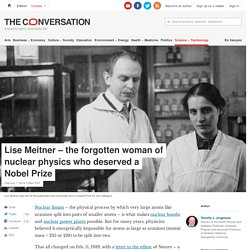
But for many years, physicists believed it energetically impossible for atoms as large as uranium (atomic mass = 235 or 238) to be split into two. Why everybody laughs at Williamson, Lynn Margulis’ “best friend” RationalWiki. Andart: Tables of Soyga: the first cellular automaton? Tables of Soyga: the first cellular automaton?
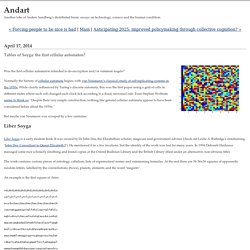
Was the first cellular automaton intended to do encryption and/or summon angels? Normally the history of cellular automata begins with von Neumann’s classical study of self-replicating systems in the 1950s. While clearly influenced by Turing’s discrete automata, this was the first paper using a grid of cells in different states where each cell changed each clock tick according to a fixed, universal rule.
National Center for Biotechnology Information. New England Complex Systems Institute. Scirus - for scientific information. Web of Knowledge - IP & Science - Thomson Reuters. Practical guides : Statistics for Biologists. Science Frontiers Digest of Scientific Anomalies. Science, Pseudoscience, and Irrationalism. Steven Dutch, Natural and Applied Sciences, University of Wisconsin - Green Bay First-time Visitors: Please visit Site Map and Disclaimer.
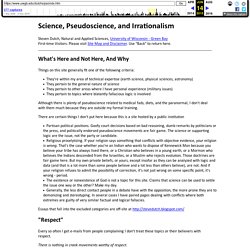
Use "Back" to return here. What's Here and Not Here, And Why Things on this site generally fit one of the following criteria: They're within my area of technical expertise (earth science, physical sciences, astronomy) They pertain to the general nature of science They pertain to other areas where I have personal experience (military issues) They pertain to topics where blatantly fallacious logic is involved. Global Cybersecurity Index. Lab-grown mini brains shed light on how humans split from great apes. Humans diverged from chimpanzees and other great apes roughly 6m years ago.
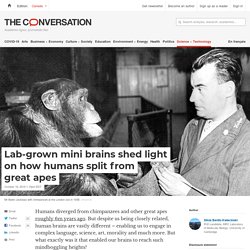
But despite us being closely related, human brains are vastly different – enabling us to engage in complex language, science, art, morality and much more. But what exactly was it that enabled our brains to reach such mindboggling heights? We know that the human brain has dramatically expanded in size over the past 6m years. Humans are in fact the mammals with the largest brain relative to body size.
But which specific evolutionary genetic changes enabled larger and more complex brains has long remained a bit of a mystery. One important reason why it has been so hard to study primate brain development is that, until relatively recently, scientists did not have access to living, developing brain tissue. But in the last few years, scientists have worked out how to make lab-grown models of developing brain tissue – so-called brain organoids – to begin to address these questions.
Genetics of evolution. Growing brains in labs: why it's time for an ethical debate. “I have never seen so many brains out of their heads before!”

Declares Dr Michael Hfuhruhurr, the world-renowned neurosurgeon played by Steve Martin who has a love affair with a brain in a jar in the 1983 movie, The Man with Two Brains. An in vivo model of functional and vascularized human brain organoids. 1Mertens, J., Marchetto, M.C., Bardy, C.
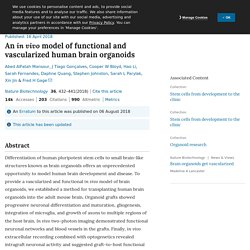
& Gage, F.H. Evaluating cell reprogramming, differentiation and conversion technologies in neuroscience. Nat. Rev. Neurosci. 17, 424–437 (2016).CAS Article Google Scholar 2Shanks, N., Greek, R. & Greek, J. Are animal models predictive for humans? AI like HAL 9000 can never exist because real emotions aren't programmable. Robots and AI could soon have feelings, hopes and rights ... we must prepare for the reckoning. Get used to hearing a lot more about artificial intelligence.
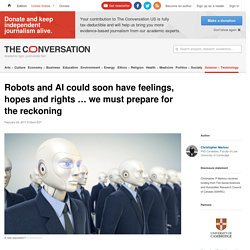
Even if you discount the utopian and dystopian hyperbole, the 21st century will broadly be defined not just by advancements in artificial intelligence, robotics, computing and cognitive neuroscience, but how we manage them. Antique Scientific Instruments. Navigating the sounds of the cosmos - 5:4. It’s been with no little excitement that i’ve watched the Curiosity Rover landing on Mars this week.
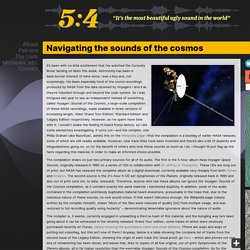
Astronomy has been a back-burner interest of mine since i was a boy and, not surprisingly, i’ve been especially fond of the sound recordings produced by NASA from the data received by Voyagers I and II as they’ve travelled through and beyond the solar system. So i was intrigued last year to see an independent release of something called Voyager: Sounds of the Cosmos, a large-scale compilation of these NASA recordings, made available in three versions of increasing length, titled ‘Grand Tour Edition’, ‘Standard Edition’ and ‘Legacy Edition’ respectively.
DARPA selects BAE to develop machine learning capabilities for space. BAE Systems has been awarded a Phase 2 contract to develop machine learning capabilities aimed to help the military gain better awareness of space scenarios for the U.S.
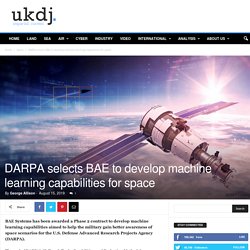
Defense Advanced Research Projects Agency (DARPA). The goal of DARPA’s Hallmark Tools, Capabilities, and Evaluation Methodology (Hallmark-TCEM) programme is to not only develop and evaluate tools and capabilities that increase an operator’s understanding of space events, but also enhance the ability to select effective courses of action for any given situation, say the firm. “Space assets such as satellites are becoming increasingly important and relied upon by the Department of Defense for communications, surveillance, and security. As part of Hallmark-TCEM, BAE Systems’ FAST Labs research and development team will build cognitive-based machine learning algorithms and data models aimed to give space operators the ability to identify abnormal activities and predict possible threats. The Artificial Intelligence Revolution: Part 1. PDF: We made a fancy PDF of this post for printing and offline viewing. Buy it here.
Curriculum Guide. Course Mapping - Center for Teaching and Learning. Physicality. Returning. Revealing. 'Rithmetic. Roaring. Rousing. Substantia. Pharmi.Co. Viruses. SCIENTIA. Blinded By SCIENCE. SCIENCES. SCIENCE Breakthroughs. TECHNOLOGY. TECHNOLOGIES. Space Places. Astronomy. Science. Conflicts of Interest. #ethics. Sciences.